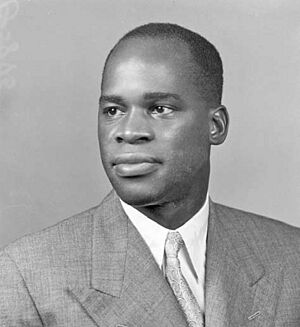Eduardo Mondlane facts for kids
Quick facts for kids
Eduardo Mondlane
|
|
|---|---|
 |
|
| Chairman of the Mozambique Liberation Front | |
| In office September 1962 – 3 February 1969 |
|
| Preceded by | Position established |
| Succeeded by | Samora Machel |
| Personal details | |
| Born |
Eduardo Chivambo Mondlane
20 June 1920 Nwajahani, Mandlakazi, Portuguese Mozambique |
| Died | 3 February 1969 (aged 48) Dar es Salaam, Tanzania |
| Political party | Mozambican Liberation Front |
| Alma mater | |
| Occupation | |
| Profession | Anthropologist |
Eduardo Chivambo Mondlane (born June 20, 1920 – died February 3, 1969) was a very important leader from Mozambique. He led the Mozambican Liberation Front (FRELIMO) from when it started in 1962 until he died in 1969. FRELIMO was a group that worked to make Mozambique independent from Portugal. Before becoming a political leader, Mondlane was an anthropologist (someone who studies human societies and cultures). He also taught history and sociology at Syracuse University in the United States.
Contents
Who Was Eduardo Mondlane?
Eduardo Chivambo Mondlane was born in 1920 in a place called N'wajahani, in what was then Portuguese East Africa (now Mozambique). He was one of 16 sons born to a chief of the Tsonga people. As a young boy, he worked as a shepherd until he was 12 years old.
He went to many different schools. He finished his high school education at a church school in South Africa. He then studied at the Witwatersrand University in Johannesburg. However, he was forced to leave South Africa in 1949. This happened after the Apartheid government came to power. Apartheid was a system of unfair racial separation.
In 1950, Mondlane went to the University of Lisbon in Portugal. Later, he moved to the United States. He studied at Oberlin College in Ohio, starting in 1951. In 1953, he earned a degree in anthropology and sociology. He continued his studies at Northwestern University in Illinois. There, he earned his master's degree in 1955 and his PhD in 1960. His studies focused on how people's roles and groups affect them.
In 1956, he married Janet Rae Johnson. She was an American woman from Indiana.
His Work as an Anthropologist
In 1957, Mondlane started working for the United Nations. This job allowed him to travel to Africa. He also worked on his PhD studies during this time. His research looked at important ideas in anthropology.
He finished his PhD in 1960. In 1961, he left his job at the United Nations. He wanted to get more involved in political activities. That same year, he started teaching at Syracuse University. He helped create a program there to study East Africa. In 1963, he left Syracuse University. He moved to Tanzania to focus on the fight for Mozambique's freedom.
Fighting for Independence
After finishing his studies, Eduardo Mondlane became an official at the United Nations. A Portuguese official named Adriano Moreira met Mondlane at the UN. He saw Mondlane's skills and offered him a job in Mozambique's government. However, Mondlane was not very interested in this offer.
Instead, he joined groups in Tanzania that wanted Mozambique to be independent. These groups needed a strong leader. In 1962, Mondlane was chosen to be the president of the new Mozambican Liberation Front (FRELIMO). This group was made up of smaller independence movements. In 1963, he set up FRELIMO's main office in Dar es Salaam, Tanzania.
FRELIMO received support from many countries. These included Western countries, the USSR, and many African nations. In 1964, FRELIMO began a fight to gain Mozambique's independence from Portugal. This was a guerrilla war, where small groups fought against a larger army.
Early on, FRELIMO's leaders had different ideas. Mondlane and many others wanted not only independence but also a change to a more equal society. Others wanted independence but not big social changes. In July 1968, the party decided to follow Mondlane's idea. He was re-elected as president. They chose a strategy of a long fight supported by the people.
How Eduardo Mondlane Died
In 1969, a package arrived for Mondlane at the FRELIMO office in Dar es Salaam, Tanzania. Inside the package was a bomb. It exploded when he opened it, killing him. Many different groups have been thought to be responsible for his death. These include rivals within FRELIMO, some Tanzanian politicians, and the Portuguese secret service. An agent from the Portuguese secret police later claimed he planted the bomb.
His Lasting Impact
Many people were very sad when Mondlane died in 1969. His friend, Reverend Edward Hawley, spoke at his funeral. He said that Mondlane "gave his life for the truth that people deserve dignity and to decide their own future."
By the early 1970s, FRELIMO's fighters had taken control of some parts of Mozambique. The Portuguese government had about 60,000 soldiers there. They were building a large dam called Cahora Bassa.
In 1974, the Portuguese government changed after a military takeover in Lisbon. This led to a big change in Portugal's policy towards its overseas lands. On June 25, 1975, Portugal gave power to FRELIMO. Mozambique then became an independent country.
Mondlane's wife, Janet Rae Johnson, worked in different government jobs in Mozambique. His daughter, Nyeleti Mondlane, later became a government minister.
Eduardo Mondlane University
In 1975, a university in Mozambique's capital city was renamed. It became the Universidade Eduardo Mondlane, or Eduardo Mondlane University. This university is in Maputo, the capital of independent Mozambique.
Eduardo Mondlane Lecture Series
Syracuse University in the United States has a special lecture series. It is called the Eduardo Mondlane Brown Bag Lecture Series. It invites speakers from all over the world to talk about African studies.
Books by and About Mondlane
- Eduardo Mondlane, The Struggle for Mozambique. 1969, Harmondsworth: Penguin Books.
- Robert, Faris, Liberating Mission in Mozambique. Faith and Revolution in the Life of Eduardo Mondlane, Eugene OR: Pickwick, 2014.

